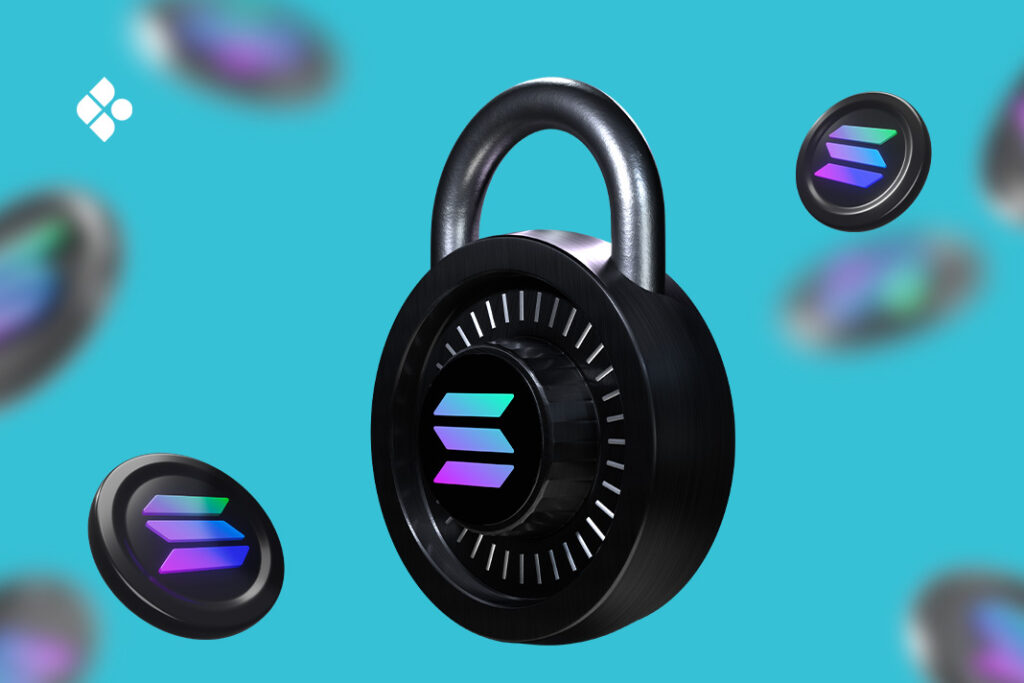Looking for a way to earn passive income from your Solana? Staking SOL might be the answer. The process is pretty straightforward. You only need a few things to start earning rewards: a staking provider, a validator, and your tokens. But if this is your first time, the terms mentioned above might sound strange. Don’t worry; I’m here to help. This article walks you through everything you need to know about staking Solana to earn rewards. We cover how the whole process works and navigating SOL staking as a beginner.
How Does Staking Solana Work

The staking setup in Solana is slightly different from Ethereum’s. On the Solana network, staking SOL lets you choose validators you trust. This contributes to the PoS mechanism on SOL and helps maintain security by delegating more transactions to validators with the most votes (honest validators). You then receive rewards based on the amount of SOL you have staked.
There are two main methods of staking SOL:
- Independently: This method involves putting together your own hardware and software staking set-up. Staking independently offers complete control of your own software and tokens. However, coding skills and familiarity with the Solana CLI and hardware setup are required. It may also be expensive to set up.
- Through a third party: Third-party options like staking pools let you participate in staking SOL with minimal cost and little to no technical expertise. The third-party will take care of the validator node setup and open a staking wallet for you. However, ensure you use the best Solana staking pools to avoid complications.
Each method has its own merits and demerits. Generally, you’ll need a wallet, technical knowledge, and a really good hardware setup to stake independently. Staking through a third party will require just an online account, but you’ll have to perform a KYC process, which makes this method a lot less anonymous.
Things to Note Before Staking Solana – Staking Requirements
Before starting your Solana staking journey, it is important to know and have the following set up:
- A supported wallet: Choose a popular and secure wallet that supports staking SOL. Some examples are Phantom, Solflare, and Sollet.
- Validators: Your staked SOL will be delegated to a validator, so it’s important to research the right one. Pick reliable validators with a history of consistent performance. Tools like Solana Beach and Solana Compass help with that.
- Epoch Periods: This is the amount of time during which staking rewards are calculated and distributed. It is usually two to three days on Solana.
- Validator downtime: This refers to when a validator is inactive, offline or just performing below standard.
- Minimum Staking Amount: Unlike many other blockchain networks, there is no minimum amount to stake Solana. Just keep a little extra SOL for transaction fees.
How to stake Solana for passive income – Step-by-step process

As discussed earlier, two major methods of staking SOL are independently and via a third party. For the purpose of simplicity, we’d use a third party via the Phantom wallet to stake SOL using the following steps:
- Install the Phantom Wallet extension: Navigate to the Phantom Wallet extension website and install the wallet by clicking “Add to Chrome”. Then click ‘’Add extension”.
- Create a new wallet: Once the extension has been installed, click “create a new wallet” and save the generated seed phrase in a secure location. It is usually advised to write it down on paper and keep it in a safe place, as anyone with your phrase can access your funds.
Create a strong password and click “Continue”. You can now open the wallet extension anytime by clicking the extensions button on the top right side of your Chrome browser.
- Fund your wallet: You can fund your newly created wallet with the amount of SOL you want to stake plus transaction fees. To do so, send SOL to the phantom wallet address displayed on the wallet extension’s home page.
- Staking SOL: Now, to stake SOL, first click on the Solana tab on your phantom wallet’s homepage. Then, click on ”Start earning SOL”. After that, choose a validator from the recommended list of validators to whom you can delegate your tokens.
Go for validators with a high amount of delegated SOL as they are usually safer since a lot of delegators trust them with their tokens. Also, validators charge a fee for their services. Compare the validators’s fees to choose the best choice.
Once you find a suitable validator, type the amount of SOL you want to stake and click “stake.” You are ready to go once the transaction has been verified on the Solana network.
Strategies for Maximizing Staking Rewards on Solana
To maximise earnings from staking Solana. Pay attention to the following strategies:
- Diversification: Delegate your SOL to multiple validators to reduce the risk of downtime or slashing of rewards from a specific validator.
- Re-Stake Rewards: It is also a good idea to compound your profits by re-staking your rewards to get higher profits. Some platforms let you set your wallet to do this automatically.
- Avoid delegators with the highest percentage yields: You should consistently avoid delegators with very high APYs (annual percentage yield). High APYs attract a lot of SOL delegation, which eventually leads to decreased performance from the validator and, thus, reduced stake yields.
- Liquid Staking: Consider staking in protocols that assign tokens to represent your staked SOL. These assigned tokens can usually be used for DeFi operations to earn additional rewards.
Benefits of Staking on Solana Network
Here are some of the benefits of staking SOL on the Solana network:
- Passive Income: Staking SOL is a great way to earn passive income while spending little time and effort.
- Network participation: By staking SOL, you are helping secure the Solana network via its PoS mechanism and aiding the network’s growth. This will, in turn, lead to better APYs as SOL price increases.
- Low Transaction Fees and Fast Transactions: Staking on the Solana network is cost-effective and much faster than staking on many other blockchains, like Ethereum.
Risks of Staking on Solana Network
Staking SOL also comes with the following risks:
- Slashing: This is the penalty for a validator acting maliciously. Your stake yields may be slashed if the validator you delegated your tokens to goes against ethical conduct.
- Volatility: Solana, like every other crypto, is volatile. So, during bearish periods, the value of your staked SOL will drop even with stake rewards.
- Validator downtime: Your staking rewards will be reduced each time the validator you chose experiences a downtime or a drop in performance.
Frequently Asked Questions (FAQs) About Staking Solana for Passive Income
How much can I earn staking Solana?
Staking rewards may fluctuate, but the average Annual Percentage Yield (APY) for staked SOL is around 6%.
This means that for every 100SOL you stake, you get around 6SOL in profit per year. You can use a Solana staking calculator to get the exact APY.
How much SOL do I need to start staking?
There is no minimum amount required to stake SOL. However, you should know that the more SOL you stake, the more your stake rewards.
Can I lose staked SOL?
Staked SOL is generally safe. However, you may lose all or part of your staked SOL if your validator is involved in malicious transactions or if your wallet is compromised.
Can I unstake my SOL anytime?
This usually depends on the platform. Some platforms, like Phantom, let you unstake your SOL anytime. However, there will be a “cool down” period during which you can’t use the unstaked SOL yet. Ensure you do your research and find out how your prospective platform works. Some platforms would require you to wait before you can unstake your SOL. Others, like Phantom, allow you to unstake whenever you want.
How often do I get rewards on my staked SOL?
On the Solana network, rewards are distributed fairly frequently, usually between two to three days.
Conclusion
Staking SOL offers a cool way to earn passive income on your SOL holdings. Whether you choose to stake independently or via a third party, it is sure to be a rewarding experience.
However, staking SOL also comes with validator penalties and market volatility risks. But, by researching prospective validators and sticking to some of the return-maximising strategies like diversification and re-staking, you’ll minimise risk and keep making profits.







